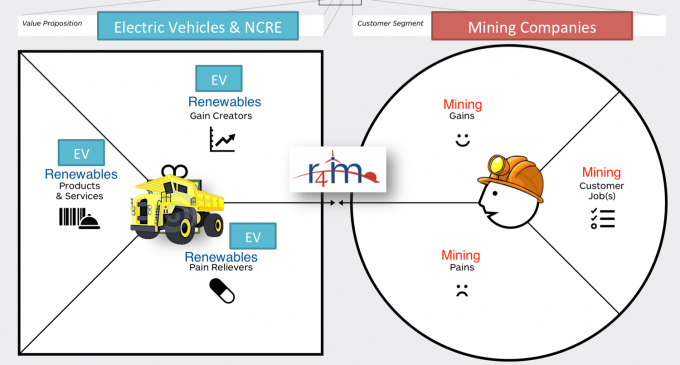24/7’s Renewable energies are meeting the Mining Industry
Dr. Arnold van den Hurk, CEO, r4mining.com
Renewable energy for mining presents two main benefits: it provides electricity and fuel for vehicles. In both forms, hybrid energy architecture can be found in both hybrid power grids (mini grids) and hybrid fuels vehicles.
This new approach to analyze Renewables for Mining emerges fueled by the rising competition in the electric vehicle marketplace. Developing a major joint ventures ecosystem involving western Silicon Valley players as Tesla, Google or Apple and battery manufacturers in China, Japan and South Korea (i. e. Panasonic, LG or Foxconn).
The rate of decreasing prices in ion-lithium batteries seems to remember descending prices evolution of the solar PV panel industry over the past decade. Prices dropped dramatically when silicon PV and silicon ingot markets begun with the development of Gigawatt factories with annual production of 1.000 MW or more. Nowadays, the history is repeating with Mr. Elon Musk and his “Tesla’s Gigafactory” at the southwest of US, a facility mainly focused on the electric vehicle and energy storage for residential renewable marketplace.
Currently, October 2015, there are 5 to 7 battery giga-factories in construction and other 5 big facilities in the pipeline, some of them dedicated to utility-scale renewable markets. This is the beginning of a new era, which will disrupt not only the automobile or IT market, but also the mining sector. The synergies among vehicle electric, solar and wind energy will transform renewables in a 24 / 7 energy value proposition for mining. Moreover, the project finance PPA business model used in NCRE mining developments would be applied to the mining vehicle marketplace as well. The entire above factors illustrate what I name as “Tesla’s Business Model for Mining”.
Some experts, like Stanford’s professor Tony Seba, the clean disruption guru, forecasts steeper reduction on prices for batteries than for the precedent solar PV sector due to the convergence of interests of the following sectors: IT + Vehicle + Residential & Utility-scale energy storage. This mainstream market revolution will drive to an astonishing paradigm change on how to do business in mining. It seems the diesel kingdom in mining will decay as electricity generator as much as for mining vehicle fuel. The rapid irruption of ion lithium batteries in global market could affect on that. Additionally, the last diesel application in mining would be for electricity generation instead of fueling mining vehicles.
In order explore the implications of this critical irruption of electric vehicles (EV) in mining, we will look at the 7 value propositions for mining with the analysis of Canvas business model I published in a recent article at Energy and Mines.
Seven Value Propositions of Electric Vehicles for Mining
Value Proposition 1: Electric Vehicles (EVs) help mining companies that want to increase transport productivity by reliable 24/7 renewable energy and 5 times higher energy efficiency unlike using internal combustion engine vehicles (ICEVs).
- Renewables energy production and battery storage allows a 24/7 energy supply. However battery storage is independent of renewables, it can be combined in a hybrid and / or non-renewable generation supply.
- An ICEV have a motor energy efficiency around 18% – 22% meanwhile an EV has between 80%-90% motor efficiency. Most of the ICEV’s energy is wasted by heat.
Value Proposition 2: EVs assist mining companies, which wish enhanced transport productivity by reducing more than 10 times the costs of fuel charge and fix the volatility of fuel prices unlike of unstable prices of fossil fuels.
- According to Consumer Goods 2012 and Clean Disruption of energy and transportation, over five years a Jeep Liberty gasoline cost $US 15,000 and a Tesla Roadster would cost $US 1,565 of electricity (12 c$US/kWh).
- One of the NCRE advantages at the Chilean copper mines is linked to the control of the volatility of fuel prices for electricity generation.
Value Proposition 3: EVs support mining companies which look to improve transport profitability by decreasing 80% to 90% maintenance costs and updating vehicle fleet for free during years instead using operational expensive vehicles composed by more than 1,000 times moving parts than EVs.
- Currently, savings in O&M costs in EVs average 87% in north America and Europe. EV are ten times cheaper to maintain, a ICEV has 2,400 moving parts meanwhile the Tesla roadster has only 18 meaning 90% fewer repairs during a “longer” lifetime for the EV car.
- EVs integrates significantly better within Big Data, SCADA and other monitoring and control mining systems than current ICEV fleets.
Value Proposition 4: EVs help mining companies who want promote higher transport security thanks to their increased power, better design flexibility, more traction control and safer fuel storage unlike the more expensive and dangerous ICE vehicles.
Value Proposition 5: EVs allow mining companies who wish take advantage for transport finance by the hand of NCRE PPA business models and bankable capital allocation to the capex upfront investment. PPA would become FPA (Fuel Purchase Agreement).
- Why not to pay mining trucks per $US/Mwh?
Value Proposition 6: EV help mining companies which need better sustainability in transport by significantly reducing GHG footprint, enhance land efficiency management and facilitate more accurate mining Corporate Social Responsibility.
Value Proposition 7: EVs help mines companies that look for improving synergies between transport and electricity using these vehicles as “moving power grid” storage, which contributes to the overall mining facility management.
The details of the above value proposition and business model integration will be one of the subjects of the next two Workshops of the Energy and Mines Summits, Toronto and London (An Introduction to mining for renewable professionals).



